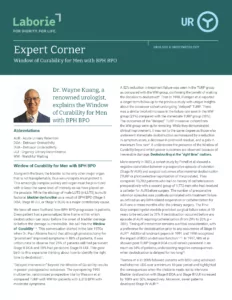Dr. Wayne Kuang, a renowned urologist, explains the Window of Curability for Men with BPH BPO
Abbreviations
AUR – Acute Urinary Retention
DOA – Detrusor Overactivity
DUA – Detrusor Underactivity
UUI – Urgency Urinary Incontinence
WW – Watchful Waiting
Window of Curability for Men with BPH BPO
Along with the brain, the bladder is the only other major organ that is not transplantable, thus we urologists must protect it. This amazingly complex solitary end-organ must be prioritized with at least the same level of intensity as we have placed on the prostate. While the etiology of male LUTS (mLUTS) is multifactorial, bladder dysfunction as a result of BPH BPO (Stage II DOA, Stage III UUI, or Stage V DUA) is a major contributory cause.
We have all seen firsthand how BPH BPO progresses in patients. Every patient has a personalized time frame within which deobstruction can occur before the onset of bladder damage or before the damage is irreversible. We call this the Window of Curability1–6. This conversation started in the late 1970s when Dr. Paul Abrams found that although prostatectomy for “prostatism” improved symptoms in 88% of patients, it was unfortunate to observe that 25% of patients still had persistent Stage II DOA and 10% had persistent Stage III UUI. This gave birth to this expansive thinking about how to identify the right time to deobstruct7.
“Delayed Intervention” beyond the Window of Curability results in poorer postoperative outcomes. The eye-opening 1995 multicenter, randomized prospective trial by Wasson et al compared TURP with WW for patients with LUTS BPH with moderate symptoms.
A 52% reduction in treatment failure was seen in the TURP group as compared with the WW group, confirming the benefit of making the decision to deobstruct8. Then in 1998, Flanigan et al reported a longer-term follow-up to the previous study with unique insights about the crossover cohort undergoing “delayed” TURP. There was a similar twofold increase in the failure rate seen in the WW group (21%) compared with the immediate TURP group (10%). The outcomes of the “delayed” TURP crossover cohort from the WW group were quite revealing. While they demonstrated clinical improvement, it was not to the same degree as those who underwent immediate deobstruction as measured by a reduction in symptom score, a decrease in post-void residual, and a gain in maximum flow rate9. It underscores the presence of the Window of Curability beyond which poorer outcomes are observed because of irreversible damage. Deobstructing at the “right time” matters.
More recently in 2023, a cohort study by Frendl et al showed a negative correlation between a preoperative episode of retention (Stage IV AUR) and surgical outcomes after maximal deobstruction (TURP or photoselective vaporization of the prostate). They compared 15,702 patients who had no history of catheterization preoperatively with a second group of 1,772 men who had received a catheter for AUR before surgery. The number of preoperative retention episodes was positively correlated with treatment failure as defined as any BPH-related reoperation or catheterization for AUR one or more months after the primary surgery. The Fine-Gray competing-risk models predicted surgical failure rates at 10 years to be reduced by 31% if deobstruction occurred before any episode of AUR requiring catheterization (from 29% to 20%; p <.001). Timing of intervention remains a critical consideration, with a preference for deobstruction prior to any occurrence of Stage IV AUR10. Additional landmark papers in 1991 and 1998 recognized the impact of BOO on detrusor function11,12. In 1997, Nitti et al showed post-TURP Stage II DOA could remain persistent in as much as 54% of patients, underscoring negative consequences when deobstruction is delayed for too long13.
Thomas et al in 2005 followed patients with BOO using advanced multichannel UDS over a minimum 10-year period and highlighted the consequences when the choice is made not to intervene. Bladder dysfunction with Stage II DOA and Stage III UUI increased by 100% and 50%, respectively. Moreover, seven patients developed Stage IV AUR 14. Inappropriately timed deobstruction often happens too late, putting patients at risk for permanent bladder damage and dysfunction, which prompted the questions of whether we are postponing deobstruction by too much and when is the optimal time to intervene5.
The preservation of detrusor function is a top priority for this non-replaceable solitary end-organ. Defining the Window of Curability for each patient will require urologists to be committed to obtaining the highest level of qualitative and quantitative data when available. These data points are found in the Advanced Category of the MVP Trident of “Urodynamics”: Cystoscopy plus Multichannel testing for both a filling-phase Cystometrogram (CMG) and a voiding-phase Pressure-Flow Study (PFS) (See the MVP Manifesto for more details on the Standard, Elevated and High levels of a diagnostic Bladder Health Baseline).
Building upon the UPSTREAM Trial, MVP encourages urologists to consider the frequently overlooked but critical benefits of pre-operative advanced multichannel urodynamics (The MVP Five Ps):
- Patient Advocacy: Men are empowered … knowing their data.
- Prognostication: Men are grateful … knowing their odds for success.
- Preventative Care: Men are appreciative … knowing that their data can prevent unnecessary surgeries and the progression of late-stage disease (Stage III UUI, Stage IV AUR, and Stage V DUA).
- Planning: Men are engaged … knowing that a multimodality treatment plan can be customized to holistically manage and treat both the obstructing prostate and the struggling bladder.
- Protection: Physicians are reassured … having the right data to make the right decisions at the right time to safeguard against legal risks and professional errors.


